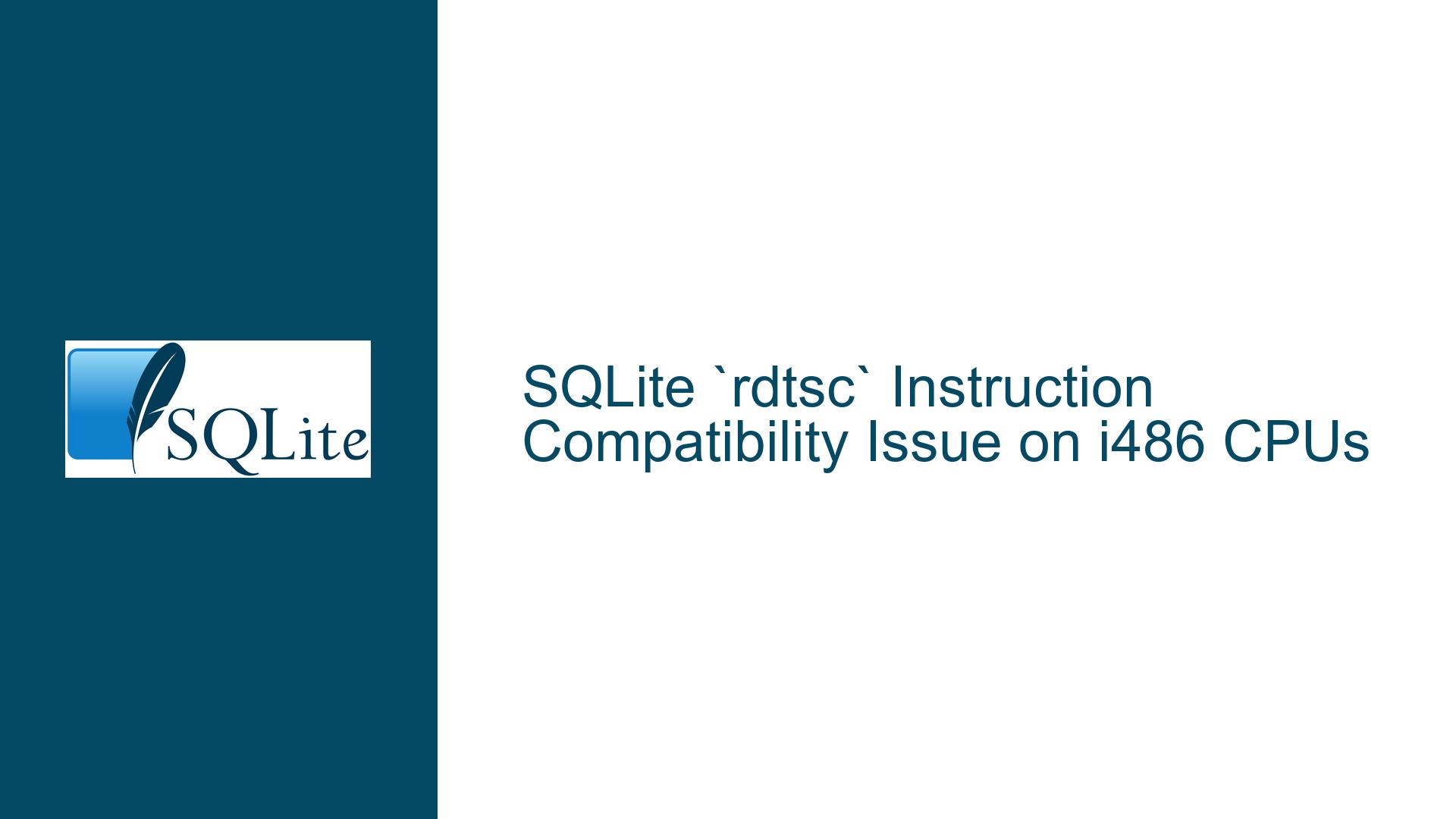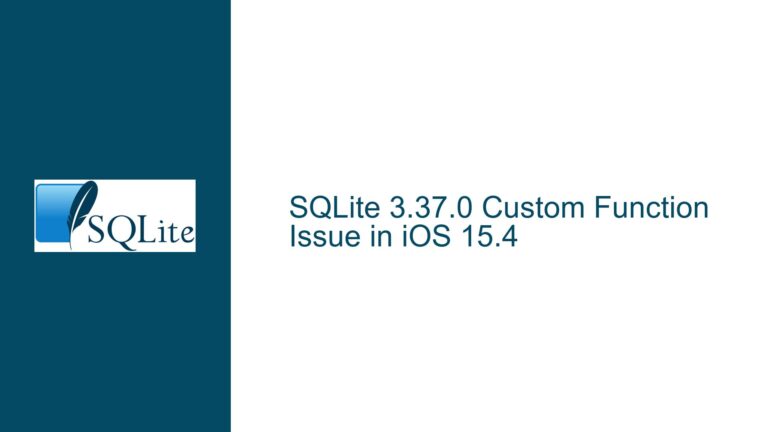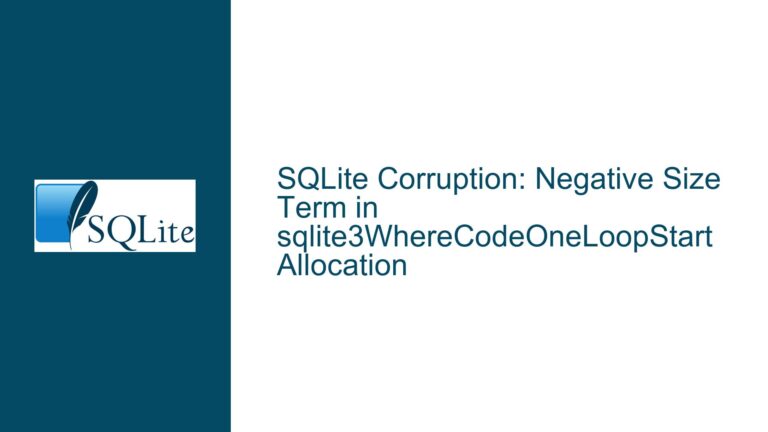SQLite `rdtsc` Instruction Compatibility Issue on i486 CPUs
Issue Overview: SQLite’s Use of rdtsc on Incompatible i486 CPUs
The core issue revolves around SQLite’s use of the rdtsc (Read Time-Stamp Counter) instruction on i486 CPUs, which do not support this instruction. The rdtsc instruction is an x86 assembly instruction used to read the CPU’s time-stamp counter, a high-resolution timer that increments with each CPU clock cycle. This instruction is commonly used for performance profiling and benchmarking purposes. However, the rdtsc instruction is not available on i486 CPUs, which are part of the x86 family but lack certain features introduced in later architectures, such as the i586 (Pentium) and beyond.
The problem arises when SQLite is compiled with the SQLITE_ENABLE_STMT_SCANSTATUS option enabled. This option is used to enable the collection of detailed statistics about SQL statement execution, which can be useful for performance analysis. When this option is enabled, SQLite uses the rdtsc instruction to gather high-resolution timing data. However, on i486 CPUs, the absence of the rdtsc instruction leads to a runtime error, as the CPU cannot execute the instruction.
The issue was first reported in the context of the Gentoo Linux distribution, where a user encountered the problem on a Soekris 4501 device powered by an AMD Elan CPU, both of which are based on the i486 architecture. The Gentoo maintainers identified that the root cause was SQLite’s use of the rdtsc instruction on these older CPUs. To address the issue, a patch was proposed to modify SQLite’s hwtime.h header file to ensure that the rdtsc instruction is only used on CPUs that support it, specifically i586 and later architectures.
The patch modifies the conditional compilation directives in hwtime.h to check for the presence of i586 or later CPU architectures instead of the more general i386 architecture. This ensures that the rdtsc instruction is only used on CPUs that are guaranteed to support it, while falling back to a stub implementation on older CPUs like the i486. This approach maintains compatibility with older hardware while still allowing the use of SQLITE_ENABLE_STMT_SCANSTATUS on more modern systems.
Possible Causes: Why SQLite’s rdtsc Usage Fails on i486 CPUs
The failure of SQLite’s rdtsc usage on i486 CPUs can be attributed to several factors, including architectural limitations, conditional compilation logic, and the specific use case of the SQLITE_ENABLE_STMT_SCANSTATUS option.
1. Architectural Limitations of i486 CPUs:
The i486 CPU architecture, while part of the x86 family, lacks certain features that were introduced in later architectures, such as the i586 (Pentium). One of these missing features is the rdtsc instruction, which was introduced with the Pentium CPU. The rdtsc instruction is used to read the CPU’s time-stamp counter, which provides a high-resolution timer that increments with each CPU clock cycle. On i486 CPUs, attempting to execute the rdtsc instruction results in an invalid opcode exception, as the CPU does not recognize the instruction.
2. Conditional Compilation Logic in SQLite:
SQLite’s hwtime.h header file contains conditional compilation directives that determine whether the rdtsc instruction should be used. The original logic in hwtime.h checks for the presence of the i386 architecture or its variants (e.g., __i386__, _M_IX86). This check is too broad, as it includes i486 CPUs, which do not support the rdtsc instruction. The conditional compilation logic should instead check for the presence of i586 or later architectures, which are guaranteed to support the rdtsc instruction.
3. Use of SQLITE_ENABLE_STMT_SCANSTATUS:
The SQLITE_ENABLE_STMT_SCANSTATUS option is used to enable the collection of detailed statistics about SQL statement execution, including timing information. When this option is enabled, SQLite uses the rdtsc instruction to gather high-resolution timing data. However, this option is unlikely to be used on i486 CPUs, as these older systems are typically not used for performance-critical applications that require detailed profiling. Nevertheless, the use of rdtsc on i486 CPUs when this option is enabled leads to a runtime error.
4. Lack of Runtime CPU Feature Detection:
SQLite does not perform runtime detection of CPU features to determine whether the rdtsc instruction is available. Instead, it relies on compile-time checks to determine whether to use the rdtsc instruction. This approach is generally more efficient, as it avoids the overhead of runtime checks. However, it also means that SQLite must be compiled with the correct conditional compilation directives to ensure compatibility with the target CPU architecture. In this case, the original conditional compilation logic in hwtime.h was not sufficiently precise, leading to the use of rdtsc on incompatible i486 CPUs.
Troubleshooting Steps, Solutions & Fixes: Ensuring rdtsc Compatibility on i486 CPUs
To address the issue of SQLite’s use of the rdtsc instruction on i486 CPUs, several steps can be taken to ensure compatibility while still allowing the use of SQLITE_ENABLE_STMT_SCANSTATUS on more modern systems. These steps include modifying the conditional compilation logic in hwtime.h, refactoring the code for better readability, and considering alternative approaches for timing on older CPUs.
1. Modifying Conditional Compilation Logic in hwtime.h:
The primary solution to the issue is to modify the conditional compilation logic in SQLite’s hwtime.h header file to ensure that the rdtsc instruction is only used on CPUs that support it. The original logic checks for the presence of the i386 architecture or its variants, which includes i486 CPUs. The modified logic should instead check for the presence of i586 or later architectures, which are guaranteed to support the rdtsc instruction.
The proposed patch modifies the conditional compilation directives in hwtime.h as follows:
#if !defined(__STRICT_ANSI__) && \
(defined(__GNUC__) || defined(_MSC_VER)) && \
(defined(i586) || defined(__i586__) || defined(_M_IX86))
This change ensures that the rdtsc instruction is only used on i586 or later CPUs, while falling back to a stub implementation on older CPUs like the i486.
2. Refactoring the Code for Better Readability:
As a style suggestion, the conditional compilation logic in hwtime.h could be refactored to pair the GCC check with GCC-specific macros and the MSVC check with MSVC-specific macros. This would make the code easier to read and maintain. For example:
#if !defined(__STRICT_ANSI__)
#if defined(__GNUC__) && (defined(i586) || defined(__i586__))
// GCC-specific code for i586 or later
#elif defined(_MSC_VER) && defined(_M_IX86)
// MSVC-specific code for i586 or later
#endif
#endif
This refactoring improves the clarity of the code by grouping related checks together and making it easier to understand which compiler and architecture combinations are being targeted.
3. Using a Stub Implementation for Older CPUs:
For CPUs that do not support the rdtsc instruction, such as the i486, SQLite should fall back to a stub implementation that provides a lower-resolution timer. This stub implementation could use the gettimeofday function or a similar system call to provide timing information. While this approach may not provide the same level of precision as the rdtsc instruction, it ensures that SQLite remains functional on older hardware.
The stub implementation could be defined as follows:
#if !defined(__STRICT_ANSI__) && \
(defined(__GNUC__) || defined(_MSC_VER)) && \
(defined(i586) || defined(__i586__) || defined(_M_IX86))
// Use rdtsc for i586 or later CPUs
#else
// Fall back to a stub implementation for older CPUs
static inline sqlite3_uint64 sqlite3Hwtime(void) {
struct timeval tv;
gettimeofday(&tv, NULL);
return (sqlite3_uint64)tv.tv_sec * 1000000 + tv.tv_usec;
}
#endif
This approach ensures that SQLite can still provide timing information on older CPUs, albeit with lower resolution.
4. Considering Alternative Approaches for Timing:
In addition to modifying the conditional compilation logic and using a stub implementation, it may be worth considering alternative approaches for timing on older CPUs. For example, SQLite could use the clock_gettime function with the CLOCK_MONOTONIC clock source, which provides a high-resolution monotonic clock that is not subject to system clock adjustments. This approach would provide better timing resolution than gettimeofday while still being compatible with older CPUs.
The use of clock_gettime could be implemented as follows:
#if !defined(__STRICT_ANSI__) && \
(defined(__GNUC__) || defined(_MSC_VER)) && \
(defined(i586) || defined(__i586__) || defined(_M_IX86))
// Use rdtsc for i586 or later CPUs
#else
// Fall back to clock_gettime for older CPUs
static inline sqlite3_uint64 sqlite3Hwtime(void) {
struct timespec ts;
clock_gettime(CLOCK_MONOTONIC, &ts);
return (sqlite3_uint64)ts.tv_sec * 1000000000 + ts.tv_nsec;
}
#endif
This approach provides a higher-resolution timer than gettimeofday and is still compatible with older CPUs that do not support the rdtsc instruction.
5. Testing and Validation:
After implementing the changes to hwtime.h, it is important to thoroughly test SQLite on both i486 and i586 (or later) CPUs to ensure that the rdtsc instruction is only used on compatible hardware. This testing should include compiling SQLite with the SQLITE_ENABLE_STMT_SCANSTATUS option enabled and running a series of performance tests to verify that the timing data is being collected correctly.
On i486 CPUs, the tests should verify that SQLite falls back to the stub implementation and does not attempt to use the rdtsc instruction. On i586 or later CPUs, the tests should verify that SQLite uses the rdtsc instruction and provides accurate timing data.
6. Documentation and Communication:
Finally, it is important to document the changes to hwtime.h and communicate them to the SQLite user community. This documentation should include a clear explanation of the issue, the changes that were made to address it, and any potential impact on performance or compatibility. This will help ensure that users are aware of the changes and can make informed decisions about whether to enable the SQLITE_ENABLE_STMT_SCANSTATUS option on their systems.
In conclusion, the issue of SQLite’s use of the rdtsc instruction on i486 CPUs can be effectively addressed by modifying the conditional compilation logic in hwtime.h, refactoring the code for better readability, using a stub implementation for older CPUs, and considering alternative approaches for timing. By following these steps, SQLite can maintain compatibility with older hardware while still providing accurate timing data on more modern systems.






